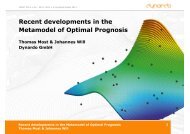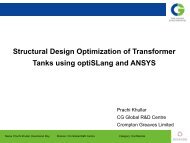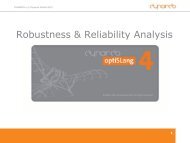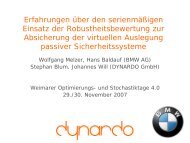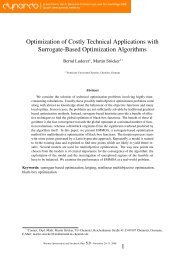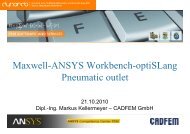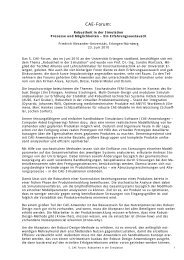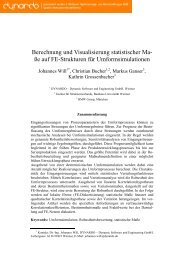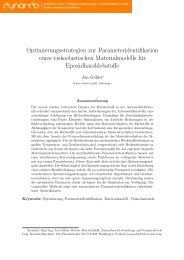Probability-based Robust Design Optimization of a ... - Dynardo GmbH
Probability-based Robust Design Optimization of a ... - Dynardo GmbH
Probability-based Robust Design Optimization of a ... - Dynardo GmbH
Create successful ePaper yourself
Turn your PDF publications into a flip-book with our unique Google optimized e-Paper software.
Introduction<br />
<strong>Probability</strong>-<strong>based</strong> robust design optimization<br />
Sequential robust design optimization<br />
<strong>Probability</strong>-<strong>based</strong> <strong>Robust</strong> <strong>Design</strong><br />
<strong>Optimization</strong> <strong>of</strong> a Radial Compressor<br />
concerning Fluid-Structure Interaction<br />
Kevin Cremanns, Dirk Roos<br />
Institute <strong>of</strong> Modelling and High-Performance Computing,<br />
Niederrhein University <strong>of</strong> Applied Sciences<br />
Johannes Einzinger<br />
ANSYS Germany <strong>GmbH</strong><br />
Hochschule Niederrhein<br />
University <strong>of</strong> Applied Sciences<br />
IMH<br />
Institut für Modellbildung<br />
und Hochleistungsrechnen<br />
Institute <strong>of</strong> Modelling<br />
and High-Performance Computing<br />
K. Cremanns, D. Roos & J. Einzinger <strong>Probability</strong>-<strong>based</strong> <strong>Robust</strong> <strong>Design</strong> <strong>Optimization</strong> WOST 2012 1 / 49
Introduction<br />
<strong>Probability</strong>-<strong>based</strong> robust design optimization<br />
Sequential robust design optimization<br />
Motivation<br />
CAE process integration<br />
Radial compressor example<br />
<strong>Optimization</strong> concerning uncertainties<br />
Power plant 1000<br />
MW, η ca. 50%<br />
Increasing <strong>of</strong> 2%<br />
results in<br />
additional +20<br />
MW power<br />
Per person, P = 1/6 kW<br />
Electricity for 20 MW / 1/6 kW = 120.000 inhabitants<br />
Maximal efficiency vs. maximal life time<br />
Six Sigma <strong>Design</strong> P(F) ≤ 3.4 · 10−6 Hochschule Niederrhein<br />
University <strong>of</strong> Applied Sciences<br />
IMH<br />
Institut für Modellbildung<br />
und Hochleistungsrechnen<br />
Institute <strong>of</strong> Modelling<br />
and High-Performance Computing<br />
K. Cremanns, D. Roos & J. Einzinger <strong>Probability</strong>-<strong>based</strong> <strong>Robust</strong> <strong>Design</strong> <strong>Optimization</strong> WOST 2012 2 / 49
Introduction<br />
<strong>Probability</strong>-<strong>based</strong> robust design optimization<br />
Sequential robust design optimization<br />
Workbench and optiSLang<br />
Motivation<br />
CAE process integration<br />
Radial compressor example<br />
Integration <strong>of</strong> structural, modal and fluid analysis (FSI)<br />
CAD- and CAE-<strong>based</strong> parameterization, automatic meshing<br />
Process integration, stochastic analysis and optimization<br />
K. Cremanns, D. Roos & J. Einzinger <strong>Probability</strong>-<strong>based</strong> <strong>Robust</strong> <strong>Design</strong> <strong>Optimization</strong> WOST 2012 3 / 49
Introduction<br />
<strong>Probability</strong>-<strong>based</strong> robust design optimization<br />
Sequential robust design optimization<br />
Workbench and optiSLang<br />
Motivation<br />
CAE process integration<br />
Radial compressor example<br />
Integration <strong>of</strong> structural, modal and fluid analysis (FSI)<br />
CAD- and CAE-<strong>based</strong> parameterization, automatic meshing<br />
Process integration, stochastic analysis and optimization<br />
K. Cremanns, D. Roos & J. Einzinger <strong>Probability</strong>-<strong>based</strong> <strong>Robust</strong> <strong>Design</strong> <strong>Optimization</strong> WOST 2012 3 / 49
Introduction<br />
<strong>Probability</strong>-<strong>based</strong> robust design optimization<br />
Sequential robust design optimization<br />
Workbench and optiSLang<br />
Motivation<br />
CAE process integration<br />
Radial compressor example<br />
Integration <strong>of</strong> structural, modal and fluid analysis (FSI)<br />
CAD- and CAE-<strong>based</strong> parameterization, automatic meshing<br />
Process integration, stochastic analysis and optimization<br />
K. Cremanns, D. Roos & J. Einzinger <strong>Probability</strong>-<strong>based</strong> <strong>Robust</strong> <strong>Design</strong> <strong>Optimization</strong> WOST 2012 3 / 49
Introduction<br />
<strong>Probability</strong>-<strong>based</strong> robust design optimization<br />
Sequential robust design optimization<br />
Workbench and optiSLang<br />
Motivation<br />
CAE process integration<br />
Radial compressor example<br />
Integration <strong>of</strong> structural, modal and fluid analysis (FSI)<br />
CAD- and CAE-<strong>based</strong> parameterization, automatic meshing<br />
Process integration, stochastic analysis and optimization<br />
K. Cremanns, D. Roos & J. Einzinger <strong>Probability</strong>-<strong>based</strong> <strong>Robust</strong> <strong>Design</strong> <strong>Optimization</strong> WOST 2012 3 / 49
Introduction<br />
<strong>Probability</strong>-<strong>based</strong> robust design optimization<br />
Sequential robust design optimization<br />
Workbench and optiSLang<br />
Motivation<br />
CAE process integration<br />
Radial compressor example<br />
Integration <strong>of</strong> structural, modal and fluid analysis (FSI)<br />
CAD- and CAE-<strong>based</strong> parameterization, automatic meshing<br />
Process integration, stochastic analysis and optimization<br />
K. Cremanns, D. Roos & J. Einzinger <strong>Probability</strong>-<strong>based</strong> <strong>Robust</strong> <strong>Design</strong> <strong>Optimization</strong> WOST 2012 3 / 49
Introduction<br />
<strong>Probability</strong>-<strong>based</strong> robust design optimization<br />
Sequential robust design optimization<br />
Workbench and optiSLang<br />
Motivation<br />
CAE process integration<br />
Radial compressor example<br />
Integration <strong>of</strong> structural, modal and fluid analysis (FSI)<br />
CAD- and CAE-<strong>based</strong> parameterization, automatic meshing<br />
Process integration, stochastic analysis and optimization<br />
K. Cremanns, D. Roos & J. Einzinger <strong>Probability</strong>-<strong>based</strong> <strong>Robust</strong> <strong>Design</strong> <strong>Optimization</strong> WOST 2012 3 / 49
Introduction<br />
<strong>Probability</strong>-<strong>based</strong> robust design optimization<br />
Sequential robust design optimization<br />
Workbench and optiSLang<br />
Motivation<br />
CAE process integration<br />
Radial compressor example<br />
Integration <strong>of</strong> structural, modal and fluid analysis (FSI)<br />
CAD- and CAE-<strong>based</strong> parameterization, automatic meshing<br />
Process integration, stochastic analysis and optimization<br />
K. Cremanns, D. Roos & J. Einzinger <strong>Probability</strong>-<strong>based</strong> <strong>Robust</strong> <strong>Design</strong> <strong>Optimization</strong> WOST 2012 3 / 49
Introduction<br />
<strong>Probability</strong>-<strong>based</strong> robust design optimization<br />
Sequential robust design optimization<br />
Workbench and optiSLang<br />
Motivation<br />
CAE process integration<br />
Radial compressor example<br />
Integration <strong>of</strong> structural, modal and fluid analysis (FSI)<br />
CAD- and CAE-<strong>based</strong> parameterization, automatic meshing<br />
Process integration, stochastic analysis and optimization<br />
K. Cremanns, D. Roos & J. Einzinger <strong>Probability</strong>-<strong>based</strong> <strong>Robust</strong> <strong>Design</strong> <strong>Optimization</strong> WOST 2012 3 / 49
Introduction<br />
<strong>Probability</strong>-<strong>based</strong> robust design optimization<br />
Sequential robust design optimization<br />
Parametric CAE model with<br />
Motivation<br />
CAE process integration<br />
Radial compressor example<br />
n d = 38 design parameters (geometry), nr = 51 random<br />
variables (geometry, material and process), mu = 71 constraints<br />
(stress and eigenfrequency resonance), objective: efficiency η<br />
K. Cremanns, D. Roos & J. Einzinger <strong>Probability</strong>-<strong>based</strong> <strong>Robust</strong> <strong>Design</strong> <strong>Optimization</strong> WOST 2012 4 / 49
Introduction<br />
<strong>Probability</strong>-<strong>based</strong> robust design optimization<br />
Sequential robust design optimization<br />
<strong>Optimization</strong> concerning uncertainties<br />
Sigma level vs. failure probability<br />
Iterative robust design optimization<br />
<strong>Probability</strong>-<strong>based</strong> robust design optimization<br />
f (d1,d2,...dn ,σ d 2 X1 ,σ2 X2 ,...σ2 Xnr<br />
,P(F)) → min<br />
g k(d1,d2,...dn d )=0; k = 1,me<br />
h l(d1,d2,...dn d ) ≥ 0; l = 1,mu<br />
σ 2 X = i 1<br />
N − 1<br />
d i ∈ [d l,du] ⊂ R n d<br />
d l ≤ d i ≤ du<br />
d i = E[X i]<br />
1 − P(F)<br />
Pt ≥ 0;<br />
(F)<br />
N<br />
∑<br />
k=1<br />
σ j<br />
L<br />
σt − 1 ≥ 0<br />
L<br />
fX j (x j)<br />
�<br />
x k i − μX<br />
� �<br />
2<br />
; P(F)=<br />
i<br />
�<br />
nr ...<br />
g j(x)≤0<br />
x j<br />
d j = E[X j]<br />
fX(x)dx<br />
g(x i)=0<br />
unfeasible<br />
domain<br />
f (xi)=const di = E[Xi] fX i (x i)<br />
K. Cremanns, D. Roos & J. Einzinger <strong>Probability</strong>-<strong>based</strong> <strong>Robust</strong> <strong>Design</strong> <strong>Optimization</strong> WOST 2012 5 / 49<br />
x i
Introduction<br />
<strong>Probability</strong>-<strong>based</strong> robust design optimization<br />
Sequential robust design optimization<br />
<strong>Optimization</strong> concerning uncertainties<br />
Sigma level vs. failure probability<br />
Iterative robust design optimization<br />
Methods solving PBRDO problems<br />
Coupled PBRDO, e.g. (Choi, Tu, and Park 2001)<br />
Nesting <strong>of</strong> two distinct levels <strong>of</strong> optimization (design level and<br />
reliability level)<br />
Double-loop problem needs sensitivity analysis to analytically<br />
compute the design gradients<br />
Single-loop PBRDO, e.g. (Kharmanda, Mohamed, and Lemaire<br />
2002)<br />
Simultaneously optimization the objective function and searches<br />
for the most probable failure point.<br />
Satisfying the probabilistic constraint only at the optimal solution<br />
Sequential PBRDO, e.g. (Chen, Liu, Sheng, and Gea 2003)<br />
Iteration between optimization and uncertainty quantification<br />
Updating the optimization goals <strong>based</strong> on the most recent<br />
probabilistic assessment results<br />
Quantification <strong>of</strong> the constraints <strong>based</strong> on safety factors<br />
K. Cremanns, D. Roos & J. Einzinger <strong>Probability</strong>-<strong>based</strong> <strong>Robust</strong> <strong>Design</strong> <strong>Optimization</strong> WOST 2012 6 / 49
Introduction<br />
<strong>Probability</strong>-<strong>based</strong> robust design optimization<br />
Sequential robust design optimization<br />
<strong>Optimization</strong> concerning uncertainties<br />
Sigma level vs. failure probability<br />
Iterative robust design optimization<br />
Sigma level vs. probability <strong>of</strong> (non-)exceedance<br />
Sigma level σL is defined by a<br />
upper and lower limit state value x u,l<br />
g<br />
depending on limit state condition<br />
x u,l<br />
g := {X|g(x)=0}:<br />
E[X] ± σL · σX<br />
symmetrical case<br />
!<br />
≶ x u,l<br />
g<br />
σL ≥ xg − E[X]<br />
σX<br />
fX(x)<br />
x l g<br />
σX<br />
σX<br />
E[X]<br />
x<br />
σL · σX<br />
P(E)/2 P(E)/2<br />
(Non-)exceedance probability as function <strong>of</strong> the sigma level<br />
P(E)=P({X|X≶x u,l<br />
g })=f (σL)<br />
Hochschule Niederrhein<br />
University <strong>of</strong> Applied Sciences<br />
x u g = xg<br />
IMH<br />
Institut für Modellbildung<br />
und Hochleistungsrechnen<br />
Institute <strong>of</strong> Modelling<br />
and High-Performance Computing<br />
K. Cremanns, D. Roos & J. Einzinger <strong>Probability</strong>-<strong>based</strong> <strong>Robust</strong> <strong>Design</strong> <strong>Optimization</strong> WOST 2012 7 / 49
Introduction<br />
<strong>Probability</strong>-<strong>based</strong> robust design optimization<br />
Sequential robust design optimization<br />
<strong>Optimization</strong> concerning uncertainties<br />
Sigma level vs. failure probability<br />
Iterative robust design optimization<br />
Sigma level vs. probability <strong>of</strong> failure<br />
Failure probability as function <strong>of</strong> the<br />
sigma level, e.g.<br />
P(F)=P({X|X > xg})=f (σL)<br />
probability density function f X(x)<br />
0.4<br />
0.35<br />
0.3<br />
0.25<br />
0.2<br />
0.15<br />
0.1<br />
0.05<br />
0<br />
Gaussian distribution<br />
μ X = 0,σ X = 1<br />
xg<br />
-2 -1 0 1 2 3 4.5 6<br />
value x <strong>of</strong> the random variable X<br />
P(X|X > xg)<br />
10 0<br />
10 −2<br />
10 −4<br />
10 −6<br />
10 −8<br />
10 −10<br />
P T (F)=3.4 · 10 −6<br />
0 1 2 3 4.5 6<br />
K. Cremanns, D. Roos & J. Einzinger <strong>Probability</strong>-<strong>based</strong> <strong>Robust</strong> <strong>Design</strong> <strong>Optimization</strong> WOST 2012 8 / 49<br />
σ L<br />
σ T L
Introduction<br />
<strong>Probability</strong>-<strong>based</strong> robust design optimization<br />
Sequential robust design optimization<br />
<strong>Optimization</strong> concerning uncertainties<br />
Sigma level vs. failure probability<br />
Iterative robust design optimization<br />
Sequential robust design optimization<br />
Initial design<br />
Modification <strong>of</strong><br />
constraints g(X) and<br />
safety factors γ<br />
Sensitivity analysis<br />
Sensitive parameters<br />
Iteration 0<br />
<strong>Optimization</strong><br />
Optimal design<br />
Iteration I, II, III, IV, ...<br />
<strong>Robust</strong>ness evaluation<br />
σ L ≶ σ t L<br />
σ L ∼ = σ t L<br />
Reliability analysis<br />
P(F) ≶ P t (F)<br />
P(F) ∼ = P t (F)<br />
σI I<br />
L II<br />
σ II<br />
L<br />
σ III<br />
L<br />
σ t L<br />
gI (X) gt g (X)<br />
II (X)<br />
III<br />
<strong>Robust</strong> and safety<br />
optimal design<br />
= 4.5<br />
g III (X)<br />
K. Cremanns, D. Roos & J. Einzinger <strong>Probability</strong>-<strong>based</strong> <strong>Robust</strong> <strong>Design</strong> <strong>Optimization</strong> WOST 2012 9 / 49
Introduction<br />
<strong>Probability</strong>-<strong>based</strong> robust design optimization<br />
Sequential robust design optimization<br />
σe [Pa]<br />
Sensitivity analysis (initial design 0)<br />
<strong>Optimization</strong> and stochastic analysis I, II, III, IV<br />
Reliability analysis<br />
Sensitivity analysis (initial design 0)<br />
3e+08<br />
2.5e+08<br />
2e+08<br />
1.67e+08<br />
1.5e+08<br />
History <strong>of</strong> the von Mises stress σe<br />
5%-quantil <strong>of</strong> the yield strength nominal value σ y,5%<br />
Nominal design stress σ I d<br />
1e+08<br />
5e+07<br />
Sensitivity analysis 0<br />
N = 122<br />
0 20 40 60 80 100 120 140<br />
N number <strong>of</strong> design evaluations<br />
K. Cremanns, D. Roos & J. Einzinger <strong>Probability</strong>-<strong>based</strong> <strong>Robust</strong> <strong>Design</strong> <strong>Optimization</strong> WOST 2012 10 / 49
Introduction<br />
<strong>Probability</strong>-<strong>based</strong> robust design optimization<br />
Sequential robust design optimization<br />
Sensitivity analysis (initial design 0)<br />
<strong>Optimization</strong> and stochastic analysis I, II, III, IV<br />
Reliability analysis<br />
Sensitivity analysis (initial design 0)<br />
8<br />
INPUT parameter<br />
4 6<br />
2<br />
Coefficients <strong>of</strong> Prognosis (using MoP)<br />
full model: CoP = 69 %<br />
INPUT: ReturnVaneHubThk3<br />
3 %<br />
INPUT: ReturnVaneShdThk2<br />
4 %<br />
INPUT: InletWidth<br />
4 %<br />
INPUT: RImpeller<br />
6 %<br />
INPUT: RotorHubBeta1<br />
7 %<br />
INPUT: ReturnVaneShdBeta1<br />
9 %<br />
INPUT: RotorShdBeta1<br />
18 %<br />
INPUT: ReturnVaneHubBeta1<br />
18 %<br />
20 40 60 80<br />
CoP [%] <strong>of</strong> OUTPUT: myeta<br />
100<br />
Latin hypercube sampling<br />
and<br />
Metamodel and coefficients<br />
<strong>of</strong> optimal prognosis<br />
(MoP) and (CoP) for the<br />
efficiency η<br />
K. Cremanns, D. Roos & J. Einzinger <strong>Probability</strong>-<strong>based</strong> <strong>Robust</strong> <strong>Design</strong> <strong>Optimization</strong> WOST 2012 11 / 49
Introduction<br />
<strong>Probability</strong>-<strong>based</strong> robust design optimization<br />
Sequential robust design optimization<br />
Sensitivity analysis (initial design 0)<br />
<strong>Optimization</strong> and stochastic analysis I, II, III, IV<br />
Reliability analysis<br />
Sensitivity analysis (initial design 0)<br />
8<br />
INPUT parameter<br />
4 6<br />
2<br />
Coefficients <strong>of</strong> Prognosis (using MoP)<br />
full model: CoP = 84 %<br />
INPUT: ExitWidth<br />
1 %<br />
INPUT: RotorHubBeta3<br />
1 %<br />
INPUT: RotorHubBeta2<br />
3 %<br />
INPUT: RImpeller<br />
6 %<br />
INPUT: RotorHubBeta1<br />
7 %<br />
INPUT: RotorShdBeta3<br />
17 %<br />
INPUT: RotorShdBeta2<br />
24 %<br />
INPUT: RotorShdBeta1<br />
31 %<br />
0 20 40 60 80<br />
CoP [%] <strong>of</strong> OUTPUT: Equivalent_Stress_Maximum<br />
Most important multivariate<br />
dependencies and design<br />
parameters for the maximal<br />
von Mises stress σe<br />
K. Cremanns, D. Roos & J. Einzinger <strong>Probability</strong>-<strong>based</strong> <strong>Robust</strong> <strong>Design</strong> <strong>Optimization</strong> WOST 2012 12 / 49
Introduction<br />
<strong>Probability</strong>-<strong>based</strong> robust design optimization<br />
Sequential robust design optimization<br />
Sensitivity analysis (initial design 0)<br />
<strong>Optimization</strong> and stochastic analysis I, II, III, IV<br />
Reliability analysis<br />
Sensitivity analysis (initial design 0)<br />
5<br />
INPUT parameter<br />
2 3 4<br />
1<br />
Coefficients <strong>of</strong> Prognosis (using MoP)<br />
full model: CoP = 96 %<br />
INPUT: RotorHubBeta2<br />
0 %<br />
INPUT: RotorThkHubTE<br />
3 %<br />
INPUT: RotorHubBeta1<br />
6 %<br />
INPUT: RotorShdBeta1<br />
9 %<br />
INPUT: RImpeller<br />
77 %<br />
20 40 60 80 100<br />
CoP [%] <strong>of</strong> OUTPUT: Total_Deformation_Reported_Frequency<br />
Most important multivariate<br />
dependencies<br />
and design parameters<br />
for the first eigenfrequency<br />
K. Cremanns, D. Roos & J. Einzinger <strong>Probability</strong>-<strong>based</strong> <strong>Robust</strong> <strong>Design</strong> <strong>Optimization</strong> WOST 2012 13 / 49
Introduction<br />
<strong>Probability</strong>-<strong>based</strong> robust design optimization<br />
Sequential robust design optimization<br />
η<br />
Sensitivity analysis (initial design 0)<br />
<strong>Optimization</strong> and stochastic analysis I, II, III, IV<br />
Reliability analysis<br />
Sensitivity analysis (initial design 0)<br />
0.9<br />
0.893<br />
0.889<br />
0.88<br />
0.87<br />
0.86<br />
0.85<br />
History <strong>of</strong> the efficiency η<br />
Evolutionary optimization on MoP N = 1<br />
Efficiency <strong>of</strong> the initial design<br />
0.84<br />
0.83<br />
Sensitivity analysis 0<br />
N = 122<br />
0 20 40 60 80 100 120 140<br />
N number <strong>of</strong> design evaluations<br />
K. Cremanns, D. Roos & J. Einzinger <strong>Probability</strong>-<strong>based</strong> <strong>Robust</strong> <strong>Design</strong> <strong>Optimization</strong> WOST 2012 14 / 49
Introduction<br />
<strong>Probability</strong>-<strong>based</strong> robust design optimization<br />
Sequential robust design optimization<br />
η<br />
<strong>Design</strong> optimization I (γ = 1.5)<br />
0.91<br />
0.905<br />
0.893<br />
0.889<br />
Sensitivity<br />
analysis 0<br />
N = 122<br />
Sensitivity analysis (initial design 0)<br />
<strong>Optimization</strong> and stochastic analysis I, II, III, IV<br />
Reliability analysis<br />
History <strong>of</strong> the efficiency η<br />
0.86<br />
0.84<br />
Efficiency <strong>of</strong> the initial design<br />
<strong>Optimization</strong> I<br />
(ARSM)<br />
N = 197<br />
0 123 320 350<br />
N number <strong>of</strong> design evaluations<br />
K. Cremanns, D. Roos & J. Einzinger <strong>Probability</strong>-<strong>based</strong> <strong>Robust</strong> <strong>Design</strong> <strong>Optimization</strong> WOST 2012 15 / 49
Introduction<br />
<strong>Probability</strong>-<strong>based</strong> robust design optimization<br />
Sequential robust design optimization<br />
σe [Pa]<br />
<strong>Design</strong> optimization I (γ = 1.5)<br />
3e+08<br />
2.5e+08<br />
1.67e+08<br />
1e+08<br />
Sensitivity analysis (initial design 0)<br />
<strong>Optimization</strong> and stochastic analysis I, II, III, IV<br />
Reliability analysis<br />
History <strong>of</strong> the von Mises stress σe<br />
5%-quantil <strong>of</strong> the yield strength nominal value σ y,5%<br />
Nominal design stress σ I d<br />
5e+07<br />
Sensitivity analysis<br />
N = 122<br />
<strong>Optimization</strong> (ARSM)<br />
N = 197<br />
0 123 320 350<br />
N number <strong>of</strong> design evaluations<br />
K. Cremanns, D. Roos & J. Einzinger <strong>Probability</strong>-<strong>based</strong> <strong>Robust</strong> <strong>Design</strong> <strong>Optimization</strong> WOST 2012 16 / 49
Introduction<br />
<strong>Probability</strong>-<strong>based</strong> robust design optimization<br />
Sequential robust design optimization<br />
η<br />
<strong>Robust</strong>ness evaluation (design I)<br />
0.91<br />
0.905<br />
0.9<br />
0.89<br />
0.88<br />
0.87<br />
Sensitivity<br />
analysis 0<br />
N = 122<br />
Sensitivity analysis (initial design 0)<br />
<strong>Optimization</strong> and stochastic analysis I, II, III, IV<br />
Reliability analysis<br />
History <strong>of</strong> the efficiency η<br />
0.86<br />
Efficiency <strong>of</strong> the initial design<br />
<strong>Optimization</strong> I<br />
(ARSM)<br />
N = 197<br />
<strong>Robust</strong>ness<br />
evaluation I<br />
N = 93<br />
0.84<br />
0 123 320 413 500<br />
N number <strong>of</strong> design evaluations<br />
K. Cremanns, D. Roos & J. Einzinger <strong>Probability</strong>-<strong>based</strong> <strong>Robust</strong> <strong>Design</strong> <strong>Optimization</strong> WOST 2012 17 / 49
Introduction<br />
<strong>Probability</strong>-<strong>based</strong> robust design optimization<br />
Sequential robust design optimization<br />
σe [Pa]<br />
<strong>Robust</strong>ness evaluation (design I)<br />
3e+08<br />
2.5e+08<br />
1.67e+08<br />
Sensitivity analysis (initial design 0)<br />
<strong>Optimization</strong> and stochastic analysis I, II, III, IV<br />
Reliability analysis<br />
History <strong>of</strong> the von Mises stress σe<br />
5%-quantil <strong>of</strong> the yield strength nominal value σ y,5%<br />
Nominal design stress σ I d<br />
1e+08<br />
5e+07<br />
Sensitivity<br />
analysis 0<br />
N = 122<br />
<strong>Optimization</strong> I<br />
(ARSM)<br />
N = 197<br />
<strong>Robust</strong>ness<br />
evaluation I<br />
N = 93<br />
0 123 320 413 500<br />
N number <strong>of</strong> design evaluations<br />
K. Cremanns, D. Roos & J. Einzinger <strong>Probability</strong>-<strong>based</strong> <strong>Robust</strong> <strong>Design</strong> <strong>Optimization</strong> WOST 2012 18 / 49
Introduction<br />
<strong>Probability</strong>-<strong>based</strong> robust design optimization<br />
Sequential robust design optimization<br />
Stress limit state g(X)=σy − σe<br />
5<br />
4<br />
PDF [1e-8]<br />
2 3<br />
1<br />
0<br />
OUTPUT: Equivalent_Stress_Maximum<br />
Fitted PDF<br />
Histogram<br />
Limit line<br />
1.4 1.6 1.8 2 2.2 2.4<br />
OUTPUT: Equivalent_Stress_Maximum [1e8]<br />
��������������<br />
���� ���������� ���� ����������<br />
����� ���������� ������ ����������<br />
��� �������<br />
��������� ������ ��������� �����<br />
������������������<br />
����� ���������� ������ ����������<br />
�������� �<br />
������������������<br />
��������<br />
�������������������������<br />
�<br />
�������� ������������ �������� ������������<br />
2.5<br />
2<br />
PDF [1e-8]<br />
1 1.5<br />
0.5<br />
0<br />
INPUT: Tensile_Yield_Strength<br />
Defined PDF<br />
Histogram<br />
Limit line<br />
2.4 2.6 2.8 3 3.2<br />
INPUT: Tensile_Yield_Strength [1e8]<br />
��������������<br />
���� ���������� ���� ����������<br />
����� ���������� ������ ����������<br />
��� �������<br />
��������� ������� ��������� �����<br />
�����������������������<br />
����� ���������� ������ ���������<br />
������������������<br />
�������� ��������� �������� ���������<br />
�������������������������<br />
�������� ������������ �������� ������������<br />
Sensitivity analysis (initial design 0)<br />
<strong>Optimization</strong> and stochastic analysis I, II, III, IV<br />
Reliability analysis<br />
2<br />
1.5<br />
PDF [1e-8]<br />
1<br />
0.5<br />
0<br />
0<br />
0.25<br />
Fitted PDF<br />
Histogram<br />
Limit line<br />
INEQUAL: lsc<br />
0.5 0.75 1 1.25<br />
INEQUAL: lsc [1e8]<br />
1.5<br />
��������������<br />
���� ���������� ���� ����������<br />
����� ���������� ������ ����������<br />
��� ������<br />
��������� ������ ��������� �����<br />
������������������<br />
����� ���������� ������ ����������<br />
�����������<br />
�������� � �������� ������������<br />
�������������������������<br />
�������� ����������� �������� ������������<br />
K. Cremanns, D. Roos & J. Einzinger <strong>Probability</strong>-<strong>based</strong> <strong>Robust</strong> <strong>Design</strong> <strong>Optimization</strong> WOST 2012 19 / 49<br />
1.75
Introduction<br />
<strong>Probability</strong>-<strong>based</strong> robust design optimization<br />
Sequential robust design optimization<br />
<strong>Robust</strong>ness evaluation (design I)<br />
0.06<br />
PDF<br />
0.04<br />
0.02<br />
0<br />
INPUT: myomega<br />
685 690 695 700 705 710<br />
INPUT: myomega<br />
Defined PDF<br />
Histogram<br />
Limit line<br />
���� �����<br />
��������������<br />
���� �����<br />
����� ����� ������ �����<br />
��� ������<br />
��������� ������� ��������� �����<br />
�������������������<br />
����� ����� ������ �����<br />
���������������<br />
�������� �������� �������� ����<br />
�������������������������<br />
�������� ������� �������� ������<br />
715<br />
OUTPUT: Total_Deformation_Reported_Frequency<br />
0.008<br />
0.006<br />
PDF<br />
0.004<br />
0.002<br />
0<br />
Fitted PDF<br />
Histogram<br />
Limit line<br />
800 1000 1200 1400 1600 1800 2000<br />
OUTPUT: Total_Deformation_Reported_Frequency<br />
���� ����<br />
��������������<br />
���� ����<br />
����� ���� ������ �����<br />
��� �������<br />
��������� ������ ��������� �����<br />
������������������<br />
����� ���� ������ �����<br />
���������������<br />
�������� � �������� ��<br />
�������������������������<br />
�������� ������� �������� �������<br />
Sensitivity analysis (initial design 0)<br />
<strong>Optimization</strong> and stochastic analysis I, II, III, IV<br />
Reliability analysis<br />
PDF<br />
200<br />
150<br />
100<br />
50<br />
0<br />
0.86<br />
OUTPUT: myeta<br />
Fitted PDF<br />
Histogram<br />
Limit line<br />
0.87 0.88 0.89<br />
OUTPUT: myeta<br />
���� ������<br />
��������������<br />
���� �����<br />
0.9<br />
����� ������ ������ ��������<br />
��� �������<br />
��������� ����� ��������� �����<br />
�����������������������������������������<br />
����� ������ ������ ��������<br />
���������� �����<br />
��������������<br />
�������� � �������� ������������<br />
�������������������������<br />
�������� �������� �������� �������<br />
K. Cremanns, D. Roos & J. Einzinger <strong>Probability</strong>-<strong>based</strong> <strong>Robust</strong> <strong>Design</strong> <strong>Optimization</strong> WOST 2012 20 / 49
σ L<br />
Introduction<br />
<strong>Probability</strong>-<strong>based</strong> robust design optimization<br />
Sequential robust design optimization<br />
<strong>Robust</strong>ness evaluation (design I)<br />
5.13<br />
4.5<br />
Sigma level vs. safety factor<br />
II<br />
1.32 1.5<br />
γ <strong>of</strong> the optimized designs I-II<br />
I<br />
Sensitivity analysis (initial design 0)<br />
<strong>Optimization</strong> and stochastic analysis I, II, III, IV<br />
Reliability analysis<br />
Sigma level <strong>of</strong> the optimized<br />
design<br />
σ I L = EI [σe]<br />
σI =<br />
σe<br />
1.106 · 108<br />
= 5.13<br />
2.154 · 107 regarding safety factor used<br />
for the first optimization<br />
γ I = 1.5<br />
Target sigma level σt L = 4.5 to<br />
ensure probability <strong>of</strong> failure<br />
P(F)=3.14 · 10−6 In case <strong>of</strong> lack <strong>of</strong> prior<br />
knowledge “rule <strong>of</strong> proportion”<br />
γ II = γ I · σt L<br />
σI = 1.32<br />
L<br />
K. Cremanns, D. Roos & J. Einzinger <strong>Probability</strong>-<strong>based</strong> <strong>Robust</strong> <strong>Design</strong> <strong>Optimization</strong> WOST 2012 21 / 49
Introduction<br />
<strong>Probability</strong>-<strong>based</strong> robust design optimization<br />
Sequential robust design optimization<br />
<strong>Design</strong> optimization II (γ = 1.32)<br />
0.908<br />
0.905<br />
0.893<br />
0.889<br />
Sensitivity<br />
analysis 0<br />
N = 122<br />
Sensitivity analysis (initial design 0)<br />
<strong>Optimization</strong> and stochastic analysis I, II, III, IV<br />
Reliability analysis<br />
History <strong>of</strong> the efficiency η<br />
0.86<br />
Efficiency <strong>of</strong> the initial design<br />
<strong>Optimization</strong> I<br />
(ARSM)<br />
N = 197<br />
<strong>Robust</strong>ness<br />
evaluation I<br />
N = 93<br />
Evolutionary<br />
optimization II<br />
N = 208<br />
0.84<br />
0 123 320 413 621 700<br />
N number <strong>of</strong> design evaluations<br />
K. Cremanns, D. Roos & J. Einzinger <strong>Probability</strong>-<strong>based</strong> <strong>Robust</strong> <strong>Design</strong> <strong>Optimization</strong> WOST 2012 22 / 49
Introduction<br />
<strong>Probability</strong>-<strong>based</strong> robust design optimization<br />
Sequential robust design optimization<br />
<strong>Design</strong> optimization II (γ = 1.32)<br />
3e+08<br />
2.5e+08<br />
1.89e+08<br />
1.67e+08<br />
Sensitivity analysis (initial design 0)<br />
<strong>Optimization</strong> and stochastic analysis I, II, III, IV<br />
Reliability analysis<br />
History <strong>of</strong> the von Mises stress σe [Pa]<br />
5%-quantil <strong>of</strong> the yield strength nominal value σ y,5%<br />
Nominal design stress σ II<br />
d<br />
1e+08<br />
5e+07<br />
Sensitivity<br />
analysis 0<br />
N = 122<br />
<strong>Optimization</strong> I<br />
(ARSM)<br />
N = 197<br />
<strong>Robust</strong>ness<br />
evaluation I<br />
N = 93<br />
Evolutionary<br />
optimization II<br />
N = 208<br />
0 123 320 413 621 700<br />
N number <strong>of</strong> design evaluations<br />
K. Cremanns, D. Roos & J. Einzinger <strong>Probability</strong>-<strong>based</strong> <strong>Robust</strong> <strong>Design</strong> <strong>Optimization</strong> WOST 2012 23 / 49
Introduction<br />
<strong>Probability</strong>-<strong>based</strong> robust design optimization<br />
Sequential robust design optimization<br />
<strong>Robust</strong>ness evaluation (design II)<br />
0.908<br />
0.905<br />
0.893<br />
0.889<br />
Sensitivity<br />
analysis 0<br />
N = 122<br />
Sensitivity analysis (initial design 0)<br />
<strong>Optimization</strong> and stochastic analysis I, II, III, IV<br />
Reliability analysis<br />
History <strong>of</strong> the efficiency η<br />
0.86<br />
Efficiency <strong>of</strong> the initial design<br />
<strong>Optimization</strong> I<br />
(ARSM)<br />
N = 197<br />
<strong>Robust</strong>ness<br />
evaluation I<br />
N = 93<br />
Evolutionary<br />
optimization II<br />
N = 208<br />
RE<br />
II<br />
N = 46<br />
0.84<br />
0 123 320 413 621 667<br />
N number <strong>of</strong> design evaluations<br />
K. Cremanns, D. Roos & J. Einzinger <strong>Probability</strong>-<strong>based</strong> <strong>Robust</strong> <strong>Design</strong> <strong>Optimization</strong> WOST 2012 24 / 49
Introduction<br />
<strong>Probability</strong>-<strong>based</strong> robust design optimization<br />
Sequential robust design optimization<br />
<strong>Robust</strong>ness evaluation (design II)<br />
3e+08<br />
2.5e+08<br />
1.89e+08<br />
1.67e+08<br />
Sensitivity analysis (initial design 0)<br />
<strong>Optimization</strong> and stochastic analysis I, II, III, IV<br />
Reliability analysis<br />
History <strong>of</strong> the von Mises stress σe [Pa]<br />
5%-quantil <strong>of</strong> the yield strength nominal value σ y,5%<br />
Nominal design stress σ II<br />
d<br />
1e+08<br />
5e+07<br />
Sensitivity<br />
analysis 0<br />
N = 122<br />
<strong>Optimization</strong> I<br />
(ARSM)<br />
N = 197<br />
<strong>Robust</strong>ness<br />
evaluation I<br />
N = 93<br />
Evolutionary<br />
optimization II<br />
N = 208<br />
RE<br />
II<br />
N = 46<br />
0 123 320 413 621 667<br />
N number <strong>of</strong> design evaluations<br />
K. Cremanns, D. Roos & J. Einzinger <strong>Probability</strong>-<strong>based</strong> <strong>Robust</strong> <strong>Design</strong> <strong>Optimization</strong> WOST 2012 25 / 49
Introduction<br />
<strong>Probability</strong>-<strong>based</strong> robust design optimization<br />
Sequential robust design optimization<br />
<strong>Robust</strong>ness evaluation (design II)<br />
3<br />
2.5<br />
2<br />
PDF [1e-8]<br />
1.5<br />
1<br />
0.5<br />
0<br />
OUTPUT: Equivalent_Stress_Maximum<br />
Fitted PDF<br />
Histogram<br />
Limit line<br />
1.6 1.8 2 2.2 2.4<br />
OUTPUT: Equivalent_Stress_Maximum [1e8]<br />
��������������<br />
���� ���������� ���� ����������<br />
����� ���������� ������ ����������<br />
��� ������<br />
��������� ������ ��������� ����<br />
������������������<br />
����� ���������� ������ ����������<br />
������������������<br />
�������� � �������� ��������<br />
�������������������������<br />
�������� ������������ �������� ������������<br />
1.75<br />
1.5<br />
1.25<br />
PDF [1e-8]<br />
0.75 1<br />
0.5<br />
0.25<br />
0<br />
0<br />
0.2<br />
Fitted PDF<br />
Histogram<br />
Limit line<br />
INEQUAL: lsc<br />
0.4 0.6 0.8 1<br />
INEQUAL: lsc [1e8]<br />
Sensitivity analysis (initial design 0)<br />
<strong>Optimization</strong> and stochastic analysis I, II, III, IV<br />
Reliability analysis<br />
1.2<br />
1.4<br />
��������������<br />
���� ���������� ���� ����������<br />
����� ���������� ������ ����������<br />
��� ������<br />
��������� �������� ��������� �����<br />
������������������<br />
����� ���������� ������ ����������<br />
�����������<br />
�������� � �������� �����������<br />
�������������������������<br />
�������� ������������ �������� ������������<br />
140<br />
120<br />
100<br />
PDF<br />
80<br />
60<br />
40<br />
20<br />
0<br />
0.86<br />
0.87<br />
OUTPUT: myeta<br />
Fitted PDF<br />
Histogram<br />
Limit line<br />
0.88 0.89<br />
OUTPUT: myeta<br />
0.9<br />
���� ������<br />
��������������<br />
���� ������<br />
����� ������ ������ ��������<br />
��� ��������<br />
��������� ������ ��������� �����<br />
�����������������������������������������<br />
����� ������ ������ ��������<br />
���������� ������<br />
��������������<br />
�������� � �������� ����������<br />
�������������������������<br />
�������� �������� �������� ��������<br />
K. Cremanns, D. Roos & J. Einzinger <strong>Probability</strong>-<strong>based</strong> <strong>Robust</strong> <strong>Design</strong> <strong>Optimization</strong> WOST 2012 26 / 49
σ L<br />
Introduction<br />
<strong>Probability</strong>-<strong>based</strong> robust design optimization<br />
Sequential robust design optimization<br />
<strong>Robust</strong>ness evaluation (design II)<br />
5.13<br />
4.5<br />
3.6<br />
Sigma level vs. safety factor<br />
II<br />
II<br />
III<br />
1.32 1.426 1.5<br />
γ <strong>of</strong> the optimized designs I-III<br />
I<br />
Sensitivity analysis (initial design 0)<br />
<strong>Optimization</strong> and stochastic analysis I, II, III, IV<br />
Reliability analysis<br />
Sigma level <strong>of</strong> the optimized<br />
design II is actual<br />
σ II<br />
L = EII [σe]<br />
σII =<br />
σe<br />
9.182 · 107<br />
= 3.6 < 4.5<br />
2.551 · 107 Linear interpolation <strong>of</strong> the new<br />
safety factor<br />
γ III = 1.426<br />
We obtain the nominal design<br />
stress <strong>of</strong> the third optimization<br />
step<br />
σ III<br />
d<br />
σy,0.05 2.5 · 108<br />
= = = 1.75 · 108<br />
γIII 1.426<br />
K. Cremanns, D. Roos & J. Einzinger <strong>Probability</strong>-<strong>based</strong> <strong>Robust</strong> <strong>Design</strong> <strong>Optimization</strong> WOST 2012 27 / 49
Introduction<br />
<strong>Probability</strong>-<strong>based</strong> robust design optimization<br />
Sequential robust design optimization<br />
<strong>Design</strong> optimization III (γ = 1.43)<br />
0.909<br />
0.905<br />
0.893<br />
0.889<br />
SA<br />
N = 122<br />
Sensitivity analysis (initial design 0)<br />
<strong>Optimization</strong> and stochastic analysis I, II, III, IV<br />
Reliability analysis<br />
History <strong>of</strong> the efficiency η<br />
0.86<br />
Efficiency <strong>of</strong> the initial design<br />
DO I<br />
ARSM<br />
N = 197<br />
RE<br />
I<br />
N = 93<br />
DO II<br />
EA<br />
N = 208<br />
RE<br />
II<br />
N = 46<br />
DO III<br />
EA<br />
N = 206<br />
0.84<br />
0 123 320 413 621 667 873<br />
N number <strong>of</strong> design evaluations<br />
K. Cremanns, D. Roos & J. Einzinger <strong>Probability</strong>-<strong>based</strong> <strong>Robust</strong> <strong>Design</strong> <strong>Optimization</strong> WOST 2012 28 / 49
Introduction<br />
<strong>Probability</strong>-<strong>based</strong> robust design optimization<br />
Sequential robust design optimization<br />
<strong>Design</strong> optimization III (γ = 1.43)<br />
3e+08<br />
2.5e+08<br />
1.89e+08<br />
1.75e+08<br />
1.67e+08<br />
Sensitivity analysis (initial design 0)<br />
<strong>Optimization</strong> and stochastic analysis I, II, III, IV<br />
Reliability analysis<br />
History <strong>of</strong> the von Mises stress σe [Pa]<br />
5%-quantil <strong>of</strong> the yield strength nominal value σ y,5%<br />
1e+08<br />
SA DO I RE DO II RE DO III<br />
5e+07<br />
0<br />
N = 122<br />
ARSM<br />
N = 197<br />
I<br />
N = 93<br />
EA<br />
N = 208<br />
II<br />
N = 46<br />
EA<br />
N = 206<br />
0 123 320 413 621667 873<br />
N number <strong>of</strong> design evaluations<br />
K. Cremanns, D. Roos & J. Einzinger <strong>Probability</strong>-<strong>based</strong> <strong>Robust</strong> <strong>Design</strong> <strong>Optimization</strong> WOST 2012 29 / 49<br />
σ III<br />
d
Introduction<br />
<strong>Probability</strong>-<strong>based</strong> robust design optimization<br />
Sequential robust design optimization<br />
<strong>Robust</strong>ness evaluation (design III)<br />
0.909<br />
0.905<br />
0.893<br />
0.889<br />
SA<br />
N = 122<br />
Sensitivity analysis (initial design 0)<br />
<strong>Optimization</strong> and stochastic analysis I, II, III, IV<br />
Reliability analysis<br />
History <strong>of</strong> the efficiency η<br />
0.86<br />
Efficiency <strong>of</strong> the initial design<br />
DO I<br />
ARSM<br />
N = 197<br />
RE<br />
I<br />
N = 93<br />
DO II<br />
EA<br />
N = 208<br />
RE<br />
II<br />
N = 46<br />
DO III<br />
EA<br />
N = 206<br />
RE<br />
III<br />
N = 72<br />
0.84<br />
0 123 320 413 621 667 873 945<br />
N number <strong>of</strong> design evaluations<br />
K. Cremanns, D. Roos & J. Einzinger <strong>Probability</strong>-<strong>based</strong> <strong>Robust</strong> <strong>Design</strong> <strong>Optimization</strong> WOST 2012 30 / 49
Introduction<br />
<strong>Probability</strong>-<strong>based</strong> robust design optimization<br />
Sequential robust design optimization<br />
<strong>Robust</strong>ness evaluation (design III)<br />
3e+08<br />
2.5e+08<br />
1.89e+08<br />
1.75e+08<br />
1.67e+08<br />
Sensitivity analysis (initial design 0)<br />
<strong>Optimization</strong> and stochastic analysis I, II, III, IV<br />
Reliability analysis<br />
History <strong>of</strong> the von Mises stress σe [Pa]<br />
5%-quantil <strong>of</strong> the yield strength nominal value σ y,5%<br />
1e+08<br />
SA DO I RE DO II RE DO III RE<br />
5e+07<br />
0<br />
N = 122<br />
ARSM<br />
N = 197<br />
I<br />
N = 93<br />
EA<br />
N = 208<br />
II<br />
N = 46<br />
EA<br />
N = 206<br />
III<br />
N = 72<br />
0 123 320 413 621667 873 945<br />
N number <strong>of</strong> design evaluations<br />
K. Cremanns, D. Roos & J. Einzinger <strong>Probability</strong>-<strong>based</strong> <strong>Robust</strong> <strong>Design</strong> <strong>Optimization</strong> WOST 2012 31 / 49<br />
σ III<br />
d
Introduction<br />
<strong>Probability</strong>-<strong>based</strong> robust design optimization<br />
Sequential robust design optimization<br />
<strong>Robust</strong>ness evaluation (design III)<br />
3<br />
2.5<br />
PDF [1e-8]<br />
1.5 2<br />
1<br />
0.5<br />
0<br />
OUTPUT: Equivalent_Stress_Maximum<br />
Fitted PDF<br />
Histogram<br />
Limit line<br />
1.6 1.8 2 2.2 2.4<br />
OUTPUT: Equivalent_Stress_Maximum [1e8]<br />
��������������<br />
���� ���������� ���� ����������<br />
����� ��������� ������ ����������<br />
��� ������<br />
��������� ������ ��������� �����<br />
������������������<br />
����� ��������� ������ ����������<br />
������������������<br />
�������� � �������� ��������<br />
�������������������������<br />
�������� ������������ �������� ������������<br />
2.5<br />
2<br />
PDF [1e-8]<br />
1 1.5<br />
0.5<br />
0<br />
0<br />
Fitted PDF<br />
Histogram<br />
Limit line<br />
INEQUAL: lsc<br />
0.2 0.4 0.6 0.8 1<br />
INEQUAL: lsc [1e8]<br />
Sensitivity analysis (initial design 0)<br />
<strong>Optimization</strong> and stochastic analysis I, II, III, IV<br />
Reliability analysis<br />
1.2<br />
1.4<br />
��������������<br />
���� ���������� ���� ����������<br />
����� ���������� ������ ����������<br />
��� ������<br />
��������� ������ ��������� �����<br />
������������������<br />
����� ���������� ������ ����������<br />
�����������<br />
�������� � �������� ������������<br />
�������������������������<br />
�������� ����������� �������� �����������<br />
200<br />
150<br />
PDF<br />
100<br />
50<br />
0<br />
0.86<br />
0.87<br />
OUTPUT: myeta<br />
Fitted PDF<br />
Histogram<br />
Limit line<br />
0.88 0.89<br />
OUTPUT: myeta<br />
0.9<br />
���� ������<br />
��������������<br />
���� ������<br />
����� ������ ������ ������<br />
��� ��������<br />
��������� ������ ��������� �����<br />
�����������������������������������������<br />
����� ������ ������ ������<br />
���������� ������<br />
��������������<br />
�������� � �������� �����������<br />
�������������������������<br />
�������� �������� �������� ��������<br />
K. Cremanns, D. Roos & J. Einzinger <strong>Probability</strong>-<strong>based</strong> <strong>Robust</strong> <strong>Design</strong> <strong>Optimization</strong> WOST 2012 32 / 49<br />
0.91
Introduction<br />
<strong>Probability</strong>-<strong>based</strong> robust design optimization<br />
Sequential robust design optimization<br />
6.5<br />
5.13<br />
4.5<br />
4.1<br />
3.6<br />
<strong>Robust</strong>ness evaluation (design III)<br />
6<br />
3<br />
Sigma level σ L vs. safety factor γ<br />
II III IV I<br />
1.32 1.43 1.46 1.5 1.55<br />
γ <strong>of</strong> the optimized designs I-IV<br />
Sensitivity analysis (initial design 0)<br />
<strong>Optimization</strong> and stochastic analysis I, II, III, IV<br />
Reliability analysis<br />
Sigma level <strong>of</strong> the optimized<br />
design III is actual<br />
σ III<br />
L = EIII [σe]<br />
σIII =<br />
σe<br />
9.989 · 107<br />
= 4.1 < 4.5<br />
2.415 · 107 Quadratic interpolation <strong>of</strong> the<br />
new safety factor<br />
γ IV = 1.46<br />
We obtain the nominal design<br />
stress <strong>of</strong> the fourth optimization<br />
step<br />
σ IV<br />
d<br />
σy,0.05 2.5 · 108<br />
= = = 1.71 · 108<br />
γIV 1.46<br />
K. Cremanns, D. Roos & J. Einzinger <strong>Probability</strong>-<strong>based</strong> <strong>Robust</strong> <strong>Design</strong> <strong>Optimization</strong> WOST 2012 33 / 49
Introduction<br />
<strong>Probability</strong>-<strong>based</strong> robust design optimization<br />
Sequential robust design optimization<br />
<strong>Design</strong> optimization IV (γ = 1.46)<br />
0.91<br />
0.905<br />
0.893<br />
0.889<br />
SA<br />
N = 122<br />
Sensitivity analysis (initial design 0)<br />
<strong>Optimization</strong> and stochastic analysis I, II, III, IV<br />
Reliability analysis<br />
History <strong>of</strong> the efficiency η<br />
0.86<br />
Efficiency <strong>of</strong> the initial design<br />
DO I<br />
ARSM<br />
197<br />
RE<br />
I<br />
93<br />
DO II<br />
EA<br />
208<br />
RE<br />
II<br />
46<br />
DO III<br />
EA<br />
206<br />
RE<br />
III<br />
72<br />
DO IV<br />
EA<br />
93<br />
0.84<br />
0 123 320 413 621667 873 945 1038<br />
N number <strong>of</strong> design evaluations<br />
K. Cremanns, D. Roos & J. Einzinger <strong>Probability</strong>-<strong>based</strong> <strong>Robust</strong> <strong>Design</strong> <strong>Optimization</strong> WOST 2012 34 / 49
Introduction<br />
<strong>Probability</strong>-<strong>based</strong> robust design optimization<br />
Sequential robust design optimization<br />
<strong>Design</strong> optimization IV (γ = 1.46)<br />
3e+08<br />
2.5e+08<br />
1.89e+08<br />
1.71e+08<br />
Sensitivity analysis (initial design 0)<br />
<strong>Optimization</strong> and stochastic analysis I, II, III, IV<br />
Reliability analysis<br />
History <strong>of</strong> the von Mises stress σe [Pa]<br />
5%-quantil <strong>of</strong> the yield strength nominal value σ y,5%<br />
1e+08<br />
SA DO I RE DO II RE DO III RE DO IV<br />
5e+07<br />
0 ARSM<br />
N = 122 197<br />
I<br />
93<br />
EA<br />
208<br />
II<br />
46<br />
EA<br />
206<br />
III<br />
72<br />
EA<br />
93<br />
0 123 320 413 621667 873 945 1038<br />
N number <strong>of</strong> design evaluations<br />
K. Cremanns, D. Roos & J. Einzinger <strong>Probability</strong>-<strong>based</strong> <strong>Robust</strong> <strong>Design</strong> <strong>Optimization</strong> WOST 2012 35 / 49<br />
σ IV<br />
d
Introduction<br />
<strong>Probability</strong>-<strong>based</strong> robust design optimization<br />
Sequential robust design optimization<br />
<strong>Robust</strong>ness evaluation (design IV)<br />
0.91<br />
0.905<br />
0.893<br />
0.889<br />
SA<br />
N = 122<br />
Sensitivity analysis (initial design 0)<br />
<strong>Optimization</strong> and stochastic analysis I, II, III, IV<br />
Reliability analysis<br />
History <strong>of</strong> the efficiency η<br />
0.86<br />
Efficiency <strong>of</strong> the initial design<br />
DO I<br />
ARSM<br />
197<br />
RE<br />
I<br />
93<br />
DO II<br />
EA<br />
208<br />
RE<br />
II<br />
46<br />
DO III<br />
EA<br />
206<br />
RE<br />
III<br />
72<br />
DO IV RE<br />
EA IV<br />
93 142<br />
0.84<br />
0 123 320 413 621667 873 945 1038 1180<br />
N number <strong>of</strong> design evaluations<br />
K. Cremanns, D. Roos & J. Einzinger <strong>Probability</strong>-<strong>based</strong> <strong>Robust</strong> <strong>Design</strong> <strong>Optimization</strong> WOST 2012 36 / 49
Introduction<br />
<strong>Probability</strong>-<strong>based</strong> robust design optimization<br />
Sequential robust design optimization<br />
<strong>Robust</strong>ness evaluation (design IV)<br />
3e+08<br />
2.5e+08<br />
1.71e+08<br />
Sensitivity analysis (initial design 0)<br />
<strong>Optimization</strong> and stochastic analysis I, II, III, IV<br />
Reliability analysis<br />
History <strong>of</strong> the von Mises stress σe [Pa]<br />
5%-quantil <strong>of</strong> the yield strength nominal value σ y,5%<br />
1e+08<br />
SA DO I RE DO II RE DO III RE DO IV RE<br />
5e+07<br />
0 ARSM<br />
N = 122 197<br />
I<br />
93<br />
EA<br />
208<br />
II<br />
46<br />
EA<br />
206<br />
III<br />
72<br />
EA<br />
93<br />
IV<br />
142<br />
0 123 320 413 621667 873 945 1038 1180<br />
N number <strong>of</strong> design evaluations<br />
K. Cremanns, D. Roos & J. Einzinger <strong>Probability</strong>-<strong>based</strong> <strong>Robust</strong> <strong>Design</strong> <strong>Optimization</strong> WOST 2012 37 / 49
2<br />
1.5<br />
PDF [1e-8]<br />
1<br />
0.5<br />
0<br />
Introduction<br />
<strong>Probability</strong>-<strong>based</strong> robust design optimization<br />
Sequential robust design optimization<br />
0<br />
<strong>Robust</strong>ness evaluation IV<br />
Fitted PDF<br />
Histogram<br />
Limit line<br />
INEQUAL: lsc<br />
0.2 0.4 0.6 0.8 1 1.2 1.4<br />
INEQUAL: lsc [1e8]<br />
��������������<br />
���� ���������� ���� ����������<br />
����� ���������� ������ ���������<br />
��� ������<br />
��������� ������ ��������� ���<br />
������������������<br />
����� ���������� ������ ���������<br />
�����������<br />
�������� � �������� ������������<br />
�������������������������<br />
1.6<br />
�������� ������������ �������� ������������<br />
Sigma level <strong>of</strong> the<br />
optimized design IV:<br />
σ IV<br />
L = EIV [σe]<br />
σIV σe<br />
= 1.004 · 108<br />
2.24 · 107 = 4.48 ≈ 4.5<br />
Small standard<br />
deviation <strong>of</strong> the<br />
efficiency and<br />
very small probability<br />
(0.02%) <strong>of</strong> violation<br />
<strong>of</strong> initial efficiency<br />
Sensitivity analysis (initial design 0)<br />
<strong>Optimization</strong> and stochastic analysis I, II, III, IV<br />
Reliability analysis<br />
PDF<br />
200<br />
150<br />
100<br />
50<br />
0<br />
0.86<br />
0.87<br />
OUTPUT: myeta<br />
Fitted PDF<br />
Histogram<br />
Limit line<br />
0.88 0.89<br />
OUTPUT: myeta<br />
0.9<br />
���� ������<br />
��������������<br />
���� ������<br />
����� ������ ������ ��������<br />
��� ��������<br />
��������� ������ ��������� �����<br />
�����������������������������������������<br />
����� ������ ������ ��������<br />
���������� ������<br />
��������������<br />
0.91<br />
�������� � �������� �����������<br />
�������������������������<br />
�������� ������� �������� ��������<br />
K. Cremanns, D. Roos & J. Einzinger <strong>Probability</strong>-<strong>based</strong> <strong>Robust</strong> <strong>Design</strong> <strong>Optimization</strong> WOST 2012 38 / 49
Introduction<br />
<strong>Probability</strong>-<strong>based</strong> robust design optimization<br />
Sequential robust design optimization<br />
<strong>Robust</strong>ness evaluation IV<br />
Sensitivity analysis (initial design 0)<br />
<strong>Optimization</strong> and stochastic analysis I, II, III, IV<br />
Reliability analysis<br />
6<br />
INPUT parameter<br />
4<br />
2<br />
Coefficients <strong>of</strong> Prognosis (using MoP)<br />
full model: CoP = 52 %<br />
INPUT: RotorHubBeta1<br />
2 %<br />
INPUT: RotorShdBeta3<br />
2 %<br />
INPUT: myAirR<br />
2 %<br />
INPUT: RotorShdBeta1<br />
9 %<br />
INPUT: myomega<br />
9 %<br />
INPUT: Poissons_Ratio<br />
11 %<br />
INPUT: Density<br />
18 %<br />
0 20 40 60 80 100<br />
CoP [%] <strong>of</strong> OUTPUT: Equivalent_Stress_Maximum<br />
Metamodel and coefficients<br />
<strong>of</strong> optimal prognosis<br />
(MoP) and (CoP) for the<br />
maximal von Mises stress<br />
σe<br />
K. Cremanns, D. Roos & J. Einzinger <strong>Probability</strong>-<strong>based</strong> <strong>Robust</strong> <strong>Design</strong> <strong>Optimization</strong> WOST 2012 39 / 49
Introduction<br />
<strong>Probability</strong>-<strong>based</strong> robust design optimization<br />
Sequential robust design optimization<br />
<strong>Robust</strong>ness evaluation IV<br />
Sensitivity analysis (initial design 0)<br />
<strong>Optimization</strong> and stochastic analysis I, II, III, IV<br />
Reliability analysis<br />
6<br />
INPUT parameter<br />
4<br />
2<br />
Coefficients <strong>of</strong> Prognosis (using MoP)<br />
full model: CoP = 52 %<br />
INPUT: RotorHubBeta1<br />
2 %<br />
INPUT: RotorShdBeta3<br />
2 %<br />
INPUT: myAirR<br />
2 %<br />
INPUT: RotorShdBeta1<br />
9 %<br />
INPUT: myomega<br />
9 %<br />
INPUT: Poissons_Ratio<br />
11 %<br />
INPUT: Density<br />
18 %<br />
0 20 40 60 80 100<br />
CoP [%] <strong>of</strong> OUTPUT: Equivalent_Stress_Maximum<br />
Most important multivariate<br />
dependencies and design<br />
parameters for the maximal<br />
von Mises stress σe<br />
K. Cremanns, D. Roos & J. Einzinger <strong>Probability</strong>-<strong>based</strong> <strong>Robust</strong> <strong>Design</strong> <strong>Optimization</strong> WOST 2012 40 / 49
Introduction<br />
<strong>Probability</strong>-<strong>based</strong> robust design optimization<br />
Sequential robust design optimization<br />
Multi-domain reliability analysis<br />
Sensitivity analysis (initial design 0)<br />
<strong>Optimization</strong> and stochastic analysis I, II, III, IV<br />
Reliability analysis<br />
g(x) ⇒ ˜g(x) Advanced moving<br />
least square<br />
approximation (Roos,<br />
Adam, and Bayer 2006)<br />
<strong>of</strong><br />
highly nonlinear state<br />
and limit state functions<br />
Independency <strong>of</strong> the<br />
probability levels<br />
using directional<br />
sampling<br />
Cluster analysis is<br />
given to detect<br />
multi-domain failure<br />
states (Roos 2011)<br />
K. Cremanns, D. Roos & J. Einzinger <strong>Probability</strong>-<strong>based</strong> <strong>Robust</strong> <strong>Design</strong> <strong>Optimization</strong> WOST 2012 41 / 49
4<br />
INPUT: Tensile_Yield_Strength [1e8]<br />
2.5<br />
3<br />
3.5<br />
2<br />
Introduction<br />
<strong>Probability</strong>-<strong>based</strong> robust design optimization<br />
Sequential robust design optimization<br />
Reliability analysis design IV<br />
660<br />
INPUT: myomega vs. INPUT: Tensile_Yield_Strength<br />
( 4. Approximation )<br />
<strong>Design</strong> point<br />
Safe domain<br />
Supports<br />
Unsafe domain<br />
680<br />
700<br />
INPUT: myomega<br />
720<br />
740<br />
Sensitivity analysis (initial design 0)<br />
<strong>Optimization</strong> and stochastic analysis I, II, III, IV<br />
Reliability analysis<br />
N = 56 design evaluations<br />
failure probability: P(F)=2.5 · 10 −6 < P t (F)=3.4 · 10 −6<br />
K. Cremanns, D. Roos & J. Einzinger <strong>Probability</strong>-<strong>based</strong> <strong>Robust</strong> <strong>Design</strong> <strong>Optimization</strong> WOST 2012 42 / 49
Introduction<br />
<strong>Probability</strong>-<strong>based</strong> robust design optimization<br />
Sequential robust design optimization<br />
Reliability analysis design IV<br />
0.91<br />
0.905<br />
0.893<br />
0.889<br />
SA<br />
N = 122<br />
Sensitivity analysis (initial design 0)<br />
<strong>Optimization</strong> and stochastic analysis I, II, III, IV<br />
Reliability analysis<br />
History <strong>of</strong> the efficiency η<br />
0.86<br />
Efficiency <strong>of</strong> the initial design<br />
DO I<br />
ARSM<br />
197<br />
RE<br />
I<br />
93<br />
DO II<br />
EA<br />
208<br />
RE<br />
II<br />
46<br />
DO III<br />
EA<br />
206<br />
RE<br />
III<br />
72<br />
DO IV<br />
EA<br />
93<br />
RE<br />
IV<br />
142<br />
Reliability<br />
analysis<br />
N = 56<br />
0.84<br />
0 123 320 413 621667 873 945 1038 1236<br />
N number <strong>of</strong> design evaluations<br />
K. Cremanns, D. Roos & J. Einzinger <strong>Probability</strong>-<strong>based</strong> <strong>Robust</strong> <strong>Design</strong> <strong>Optimization</strong> WOST 2012 43 / 49
Introduction<br />
<strong>Probability</strong>-<strong>based</strong> robust design optimization<br />
Sequential robust design optimization<br />
Reliability analysis design IV<br />
3e+08<br />
2.5e+08<br />
1.71e+08<br />
Sensitivity analysis (initial design 0)<br />
<strong>Optimization</strong> and stochastic analysis I, II, III, IV<br />
Reliability analysis<br />
History <strong>of</strong> the von Mises stress σe [Pa]<br />
5%-quantil <strong>of</strong> the yield strength nominal value σ y,5%<br />
1e+08<br />
SA DO I RE DO II RE DO III RE DO IV RE Reliability<br />
5e+07<br />
0<br />
122<br />
ARSM<br />
197<br />
I<br />
93<br />
EA<br />
208<br />
II<br />
46<br />
EA<br />
206<br />
III<br />
72<br />
EA<br />
93<br />
IV<br />
142<br />
analysis<br />
N = 56<br />
0 123 320 413 621667 873 945 1038 1236<br />
N number <strong>of</strong> design evaluations<br />
K. Cremanns, D. Roos & J. Einzinger <strong>Probability</strong>-<strong>based</strong> <strong>Robust</strong> <strong>Design</strong> <strong>Optimization</strong> WOST 2012 44 / 49<br />
σ IV<br />
d
Introduction<br />
<strong>Probability</strong>-<strong>based</strong> robust design optimization<br />
Sequential robust design optimization<br />
Summary<br />
Sensitivity analysis (initial design 0)<br />
<strong>Optimization</strong> and stochastic analysis I, II, III, IV<br />
Reliability analysis<br />
<strong>Probability</strong>- and variance-<strong>based</strong> robust design optimization<br />
n d = 38 design parameters (geometry)<br />
nr = 51 random variables (geometry, material and process)<br />
Adjust the design parameter to maximize the efficiency η<br />
about 5%<br />
Electricity for 5 · 20 MW / 1/6 kW = 600.000 inhabitants<br />
(population <strong>of</strong> Stuttgart)<br />
Optimize the design such that it is insensitive to<br />
uncertainties<br />
Consideration <strong>of</strong> the failure probability (defects per million)<br />
More robust and safety designs<br />
Hochschule Niederrhein<br />
University <strong>of</strong> Applied Sciences<br />
IMH<br />
Institut für Modellbildung<br />
und Hochleistungsrechnen<br />
Institute <strong>of</strong> Modelling<br />
and High-Performance Computing<br />
K. Cremanns, D. Roos & J. Einzinger <strong>Probability</strong>-<strong>based</strong> <strong>Robust</strong> <strong>Design</strong> <strong>Optimization</strong> WOST 2012 45 / 49
Introduction<br />
<strong>Probability</strong>-<strong>based</strong> robust design optimization<br />
Sequential robust design optimization<br />
Summary<br />
Sensitivity analysis (initial design 0)<br />
<strong>Optimization</strong> and stochastic analysis I, II, III, IV<br />
Reliability analysis<br />
Nonlinear multi-physics analysis (FSI) with N = 1236<br />
design evaluations<br />
ANSYS Workbench (CFX, Mechanical, TurboTools): 4<br />
Parallel Tasks<br />
Calculation time: 2 weeks (on 12 Cores: 2 Intel® Xeon®<br />
X5680 Six Core, 3.33 GHz, 12MB Cache)<br />
Acknowledgement: thanks to Ulrike Adams and Daniela<br />
Ochsenfahrt <strong>of</strong> the DYNARDO <strong>GmbH</strong> (s<strong>of</strong>tware<br />
implementation into the optiSLang s<strong>of</strong>tware package)<br />
Hochschule Niederrhein<br />
University <strong>of</strong> Applied Sciences<br />
IMH<br />
Institut für Modellbildung<br />
und Hochleistungsrechnen<br />
Institute <strong>of</strong> Modelling<br />
and High-Performance Computing<br />
K. Cremanns, D. Roos & J. Einzinger <strong>Probability</strong>-<strong>based</strong> <strong>Robust</strong> <strong>Design</strong> <strong>Optimization</strong> WOST 2012 46 / 49
Introduction<br />
<strong>Probability</strong>-<strong>based</strong> robust design optimization<br />
Sequential robust design optimization<br />
Are there any questions?<br />
Thank you for your attention!<br />
Sensitivity analysis (initial design 0)<br />
<strong>Optimization</strong> and stochastic analysis I, II, III, IV<br />
Reliability analysis<br />
Hochschule Niederrhein<br />
University <strong>of</strong> Applied Sciences<br />
IMH<br />
Institut für Modellbildung<br />
und Hochleistungsrechnen<br />
Institute <strong>of</strong> Modelling<br />
and High-Performance Computing<br />
K. Cremanns, D. Roos & J. Einzinger <strong>Probability</strong>-<strong>based</strong> <strong>Robust</strong> <strong>Design</strong> <strong>Optimization</strong> WOST 2012 47 / 49
Literature I<br />
Appendix<br />
References<br />
Chen, W., H. Liu, J. Sheng, and H. C. Gea (2003, September 2–6).<br />
Application <strong>of</strong> the sequential optimization and reliabilty assessment method<br />
to structural design problems.<br />
In Proceedings <strong>of</strong> DETC’03, ASME 2003 <strong>Design</strong> Engineering Technical<br />
Conferences and Computers and Information in Engineering<br />
Conference, Chicao, Illinois USA.<br />
Choi, K. K., J. Tu, and Y. H. Park (2001).<br />
Extensions <strong>of</strong> design potential concept for reliability-<strong>based</strong> design<br />
optimization to nonsmooth and extreme cases.<br />
Structural and Multidisciplinary <strong>Optimization</strong> 22, 335–350.<br />
Kharmanda, G., A. Mohamed, and M. Lemaire (2002).<br />
Efficient reliability-<strong>based</strong> design optimization using a hybrid space<br />
withapplication to finite element analysis.<br />
Structural and Multidisciplinary <strong>Optimization</strong> 24, 233 – 245.<br />
Hochschule Niederrhein<br />
University <strong>of</strong> Applied Sciences<br />
IMH<br />
Institut für Modellbildung<br />
und Hochleistungsrechnen<br />
Institute <strong>of</strong> Modelling<br />
and High-Performance Computing<br />
K. Cremanns, D. Roos & J. Einzinger <strong>Probability</strong>-<strong>based</strong> <strong>Robust</strong> <strong>Design</strong> <strong>Optimization</strong> WOST 2012 48 / 49
Literature II<br />
Appendix<br />
References<br />
Roos, D. (2011, November 17-18).<br />
Multi-domain adaptive surrogate models for reliability analysis.<br />
In H. Budelmann, A. Holst, and D. Proske (Eds.), Proceedings <strong>of</strong> the 9th<br />
International Probabilistic Workshop, pp. 191 – 207. Braunschweig,<br />
Germany: Technical University Carolo-Wilhelmina zu Braunschweig.<br />
Roos, D., U. Adam, and V. Bayer (2006).<br />
<strong>Design</strong> reliability analysis.<br />
In 24th CAD-FEM USERS’ Meeting 2006. Stuttgart, Schwabenlandhalle,<br />
Germany, October 26-27, 2006: International Congress on FEM<br />
Technology with 2006 German ANSYS Conference.<br />
Wolpert, D. H. and W. G. Macready (1997).<br />
No free lunch theorems for optimization.<br />
IEEE Trans, Evolutionary Computation 1(1), 67 – 82.<br />
Hochschule Niederrhein<br />
University <strong>of</strong> Applied Sciences<br />
IMH<br />
Institut für Modellbildung<br />
und Hochleistungsrechnen<br />
Institute <strong>of</strong> Modelling<br />
and High-Performance Computing<br />
K. Cremanns, D. Roos & J. Einzinger <strong>Probability</strong>-<strong>based</strong> <strong>Robust</strong> <strong>Design</strong> <strong>Optimization</strong> WOST 2012 49 / 49



